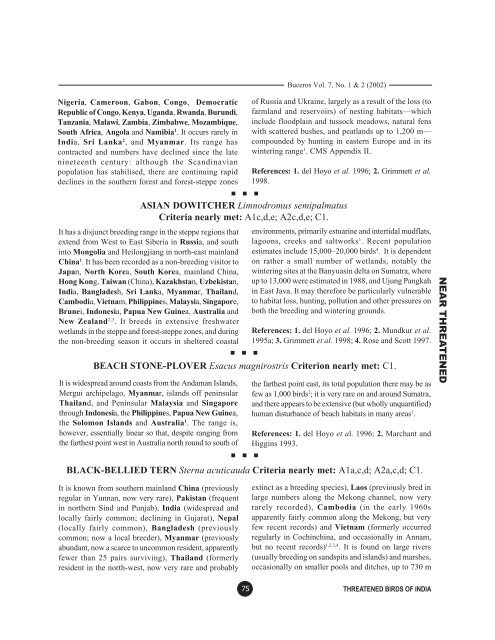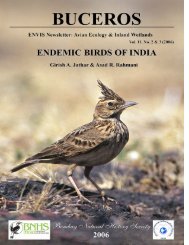Untitled - ENVIS Centre on Avian Ecology
Untitled - ENVIS Centre on Avian Ecology
Untitled - ENVIS Centre on Avian Ecology
You also want an ePaper? Increase the reach of your titles
YUMPU automatically turns print PDFs into web optimized ePapers that Google loves.
Nigeria, Camero<strong>on</strong>, Gab<strong>on</strong>, C<strong>on</strong>go, Democratic<br />
Republic of C<strong>on</strong>go, Kenya, Uganda, Rwanda, Burundi,<br />
Tanzania, Malawi, Zambia, Zimbabwe, Mozambique,<br />
South Africa, Angola and Namibia 1 . It occurs rarely in<br />
India, Sri Lanka 2 , and Myanmar. Its range has<br />
c<strong>on</strong>tracted and numbers have declined since the late<br />
nineteenth century: although the Scandinavian<br />
populati<strong>on</strong> has stabilised, there are c<strong>on</strong>tinuing rapid<br />
declines in the southern forest and forest-steppe z<strong>on</strong>es<br />
Buceros Vol. 7, No. 1 & 2 (2002)<br />
of Russia and Ukraine, largely as a result of the loss (to<br />
farmland and reservoirs) of nesting habitats—which<br />
include floodplain and tussock meadows, natural fens<br />
with scattered bushes, and peatlands up to 1,200 m—<br />
compounded by hunting in eastern Europe and in its<br />
wintering range 1 . CMS Appendix II.<br />
References: 1. del Hoyo et al. 1996; 2. Grimmett et al.<br />
1998.<br />
n n n<br />
ASIAN DOWITCHER Limnodromus semipalmatus<br />
Criteria nearly met: A1c,d,e; A2c,d,e; C1.<br />
It has a disjunct breeding range in the steppe regi<strong>on</strong>s that<br />
extend from West to East Siberia in Russia, and south<br />
into M<strong>on</strong>golia and Heil<strong>on</strong>gjiang in north-east mainland<br />
China 1 . It has been recorded as a n<strong>on</strong>-breeding visitor to<br />
Japan, North Korea, South Korea, mainland China,<br />
H<strong>on</strong>g K<strong>on</strong>g, Taiwan (China), Kazakhstan, Uzbekistan,<br />
India, Bangladesh, Sri Lanka, Myanmar, Thailand,<br />
Cambodia, Vietnam, Philippines, Malaysia, Singapore,<br />
Brunei, Ind<strong>on</strong>esia, Papua New Guinea, Australia and<br />
New Zealand 2,3 . It breeds in extensive freshwater<br />
wetlands in the steppe and forest-steppe z<strong>on</strong>es, and during<br />
the n<strong>on</strong>-breeding seas<strong>on</strong> it occurs in sheltered coastal<br />
envir<strong>on</strong>ments, primarily estuarine and intertidal mudflats,<br />
lago<strong>on</strong>s, creeks and saltworks 1 . Recent populati<strong>on</strong><br />
estimates include 15,000–20,000 birds 4 . It is dependent<br />
<strong>on</strong> rather a small number of wetlands, notably the<br />
wintering sites at the Banyuasin delta <strong>on</strong> Sumatra, where<br />
up to 13,000 were estimated in 1988, and Ujung Pangkah<br />
in East Java. It may therefore be particularly vulnerable<br />
to habitat loss, hunting, polluti<strong>on</strong> and other pressures <strong>on</strong><br />
both the breeding and wintering grounds.<br />
References: 1. del Hoyo et al. 1996; 2. Mundkur et al.<br />
1995a; 3. Grimmett et al. 1998; 4. Rose and Scott 1997.<br />
BEACH STONE-PLOVER Esacus magnirostris Criteri<strong>on</strong> nearly met: C1.<br />
It is widespread around coasts from the Andaman Islands,<br />
Mergui archipelago, Myanmar, islands off peninsular<br />
Thailand, and Peninsular Malaysia and Singapore<br />
through Ind<strong>on</strong>esia, the Philippines, Papua New Guinea,<br />
the Solom<strong>on</strong> Islands and Australia 1 . The range is,<br />
however, essentially linear so that, despite ranging from<br />
the farthest point west in Australia north round to south of<br />
n n n<br />
the farthest point east, its total populati<strong>on</strong> there may be as<br />
few as 1,000 birds 2 ; it is very rare <strong>on</strong> and around Sumatra,<br />
and there appears to be extensive (but wholly unquantified)<br />
human disturbance of beach habitats in many areas 1 .<br />
References: 1. del Hoyo et al. 1996; 2. Marchant and<br />
Higgins 1993.<br />
BLACK-BELLIED TERN Sterna acuticauda Criteria nearly met: A1a,c,d; A2a,c,d; C1.<br />
It is known from southern mainland China (previously<br />
regular in Yunnan, now very rare), Pakistan (frequent<br />
in northern Sind and Punjab), India (widespread and<br />
locally fairly comm<strong>on</strong>; declining in Gujarat), Nepal<br />
(locally fairly comm<strong>on</strong>), Bangladesh (previously<br />
comm<strong>on</strong>; now a local breeder), Myanmar (previously<br />
abundant, now a scarce to uncomm<strong>on</strong> resident, apparently<br />
fewer than 25 pairs surviving), Thailand (formerly<br />
resident in the north-west, now very rare and probably<br />
n n n<br />
extinct as a breeding species), Laos (previously bred in<br />
large numbers al<strong>on</strong>g the Mek<strong>on</strong>g channel, now very<br />
rarely recorded), Cambodia (in the early 1960s<br />
apparently fairly comm<strong>on</strong> al<strong>on</strong>g the Mek<strong>on</strong>g, but very<br />
few recent records) and Vietnam (formerly occurred<br />
regularly in Cochinchina, and occasi<strong>on</strong>ally in Annam,<br />
but no recent records) 1,2,3,4 . It is found <strong>on</strong> large rivers<br />
(usually breeding <strong>on</strong> sandspits and islands) and marshes,<br />
occasi<strong>on</strong>ally <strong>on</strong> smaller pools and ditches, up to 730 m<br />
75 THREATENED BIRDS OF INDIA<br />
NEAR THREATENED




